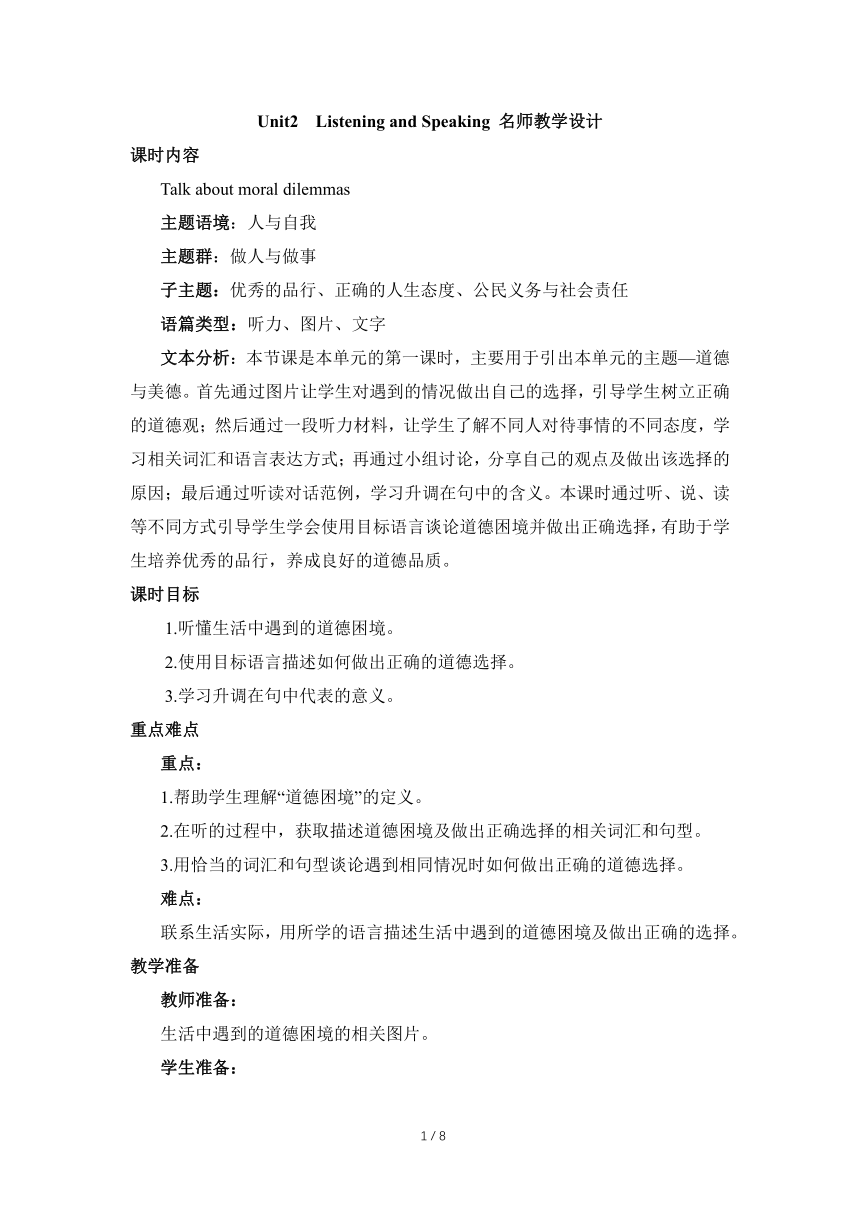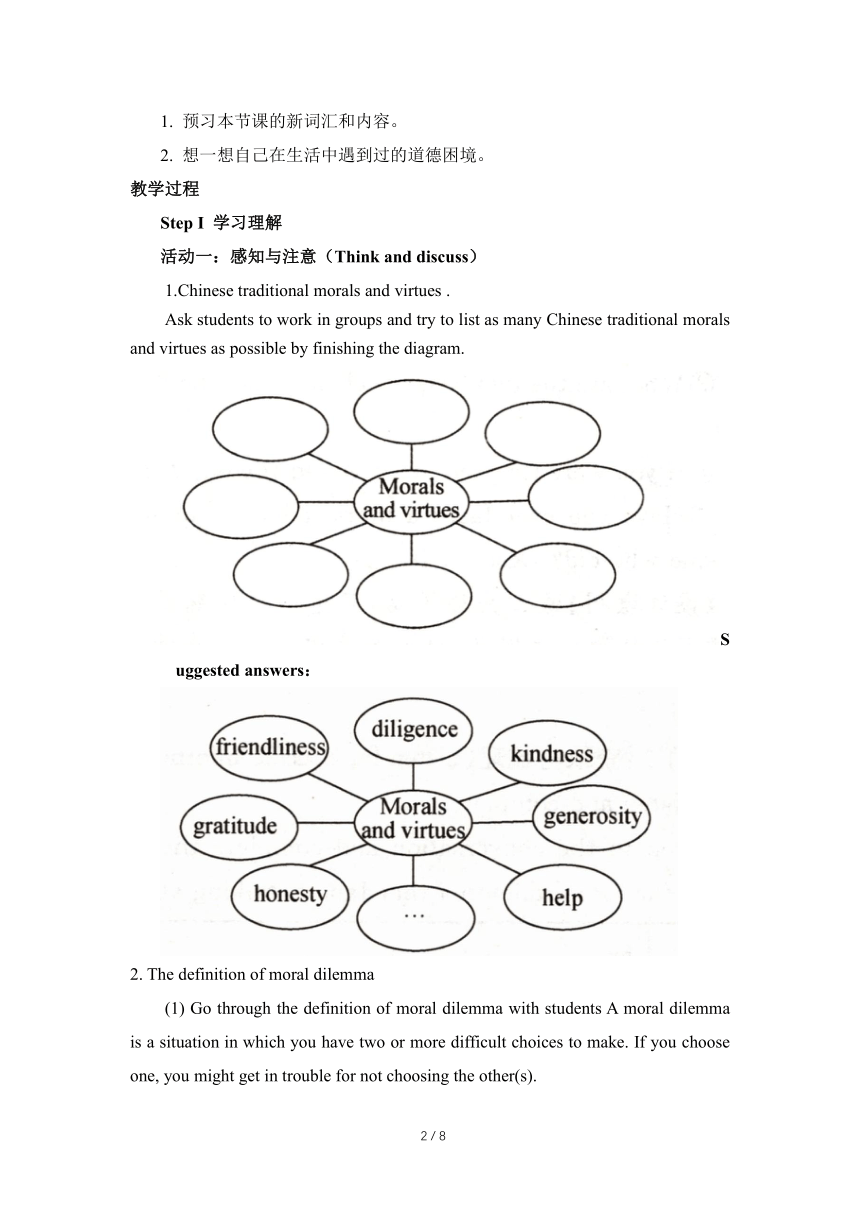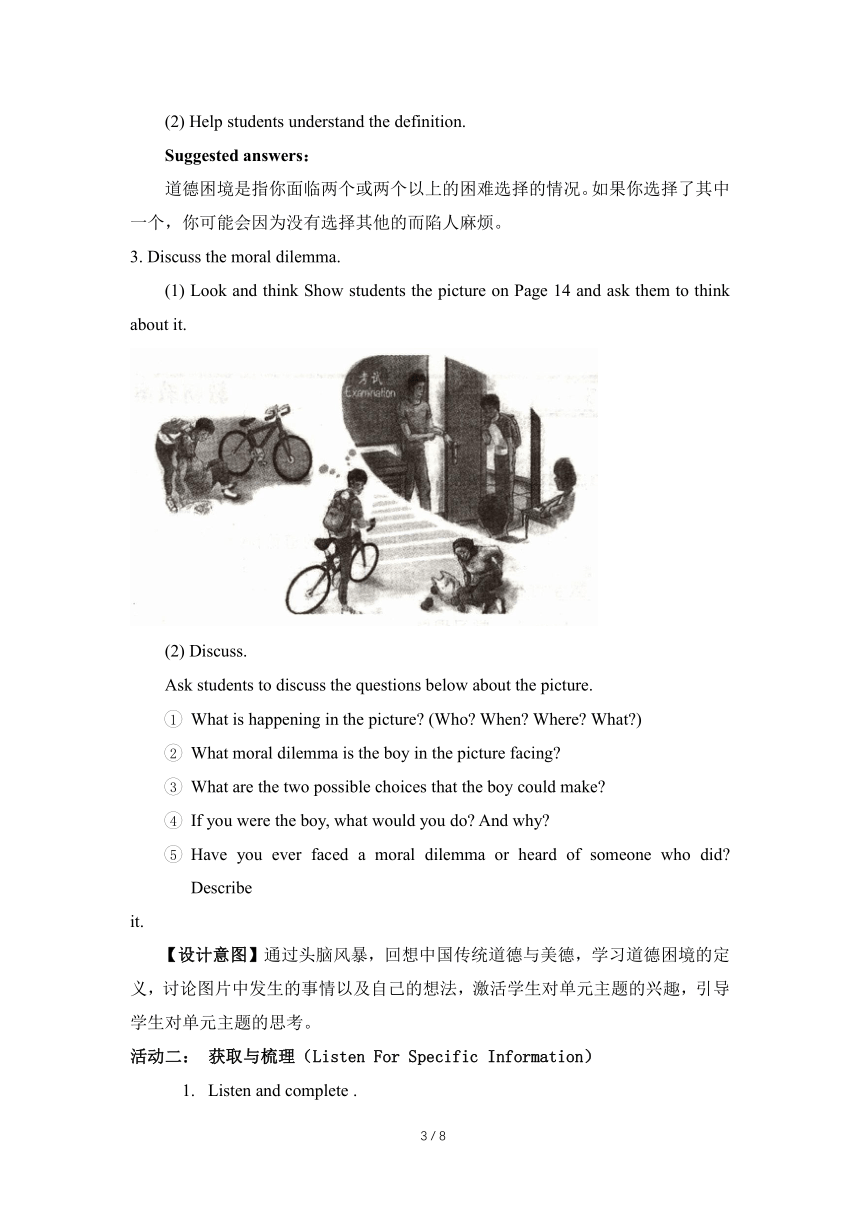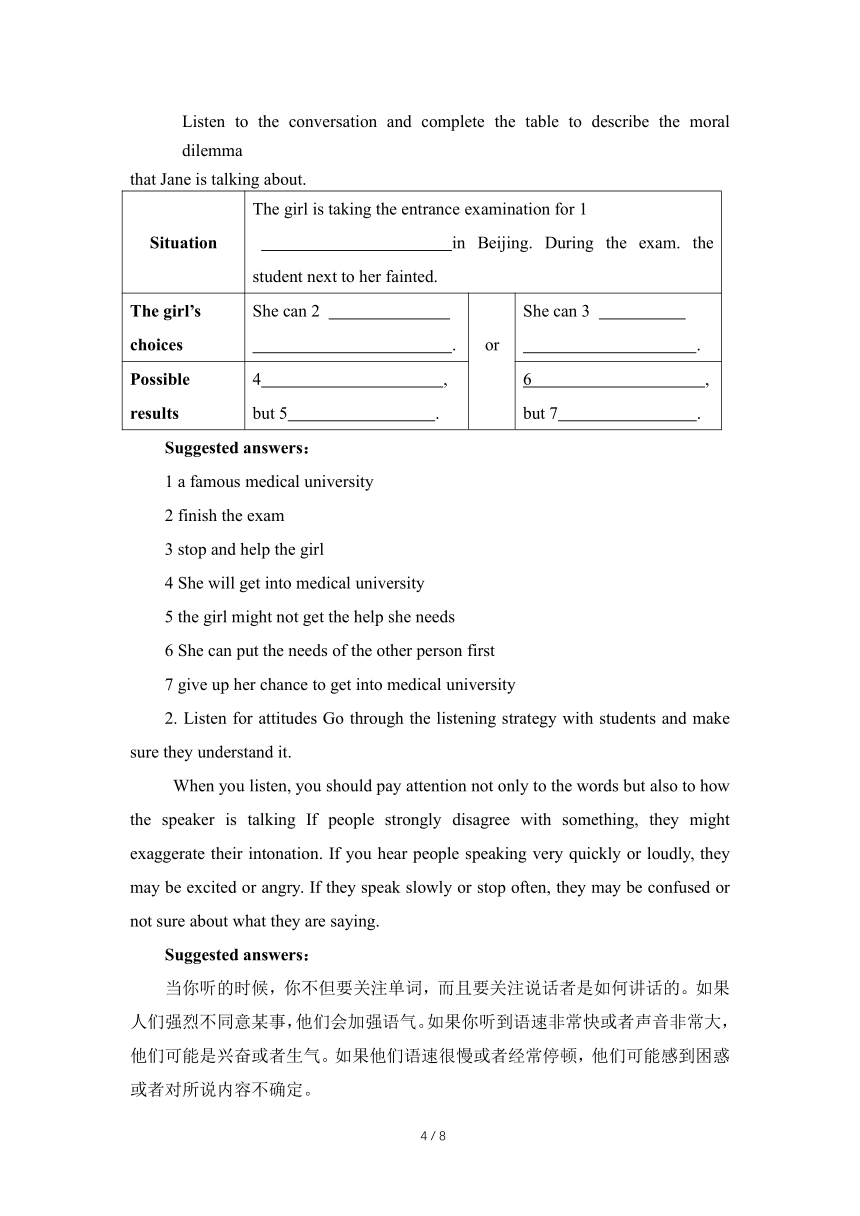人教版(2019)必修第三册 Unit2 Morals and Virtues Listening and Speaking 名师教学设计(含答案)
文档属性
| 名称 | 人教版(2019)必修第三册 Unit2 Morals and Virtues Listening and Speaking 名师教学设计(含答案) |

|
|
| 格式 | docx | ||
| 文件大小 | 1.8MB | ||
| 资源类型 | 教案 | ||
| 版本资源 | 人教版(2019) | ||
| 科目 | 英语 | ||
| 更新时间 | 2023-03-10 14:52:47 | ||
图片预览




文档简介
Unit2 Listening and Speaking 名师教学设计
课时内容
Talk about moral dilemmas
主题语境:人与自我
主题群:做人与做事
子主题:优秀的品行、正确的人生态度、公民义务与社会责任
语篇类型:听力、图片、文字
文本分析:本节课是本单元的第一课时,主要用于引出本单元的主题—道德与美德。首先通过图片让学生对遇到的情况做出自己的选择,引导学生树立正确的道德观;然后通过一段听力材料,让学生了解不同人对待事情的不同态度,学习相关词汇和语言表达方式;再通过小组讨论,分享自己的观点及做出该选择的原因;最后通过听读对话范例,学习升调在句中的含义。本课时通过听、说、读等不同方式引导学生学会使用目标语言谈论道德困境并做出正确选择,有助于学生培养优秀的品行,养成良好的道德品质。
课时目标
1.听懂生活中遇到的道德困境。
2.使用目标语言描述如何做出正确的道德选择。
3.学习升调在句中代表的意义。
重点难点
重点:
1.帮助学生理解“道德困境”的定义。
2.在听的过程中,获取描述道德困境及做出正确选择的相关词汇和句型。
3.用恰当的词汇和句型谈论遇到相同情况时如何做出正确的道德选择。
难点:
联系生活实际,用所学的语言描述生活中遇到的道德困境及做出正确的选择。
教学准备
教师准备:
生活中遇到的道德困境的相关图片。
学生准备:
1. 预习本节课的新词汇和内容。
2. 想一想自己在生活中遇到过的道德困境。
教学过程
Step I 学习理解
活动一:感知与注意(Think and discuss)
1.Chinese traditional morals and virtues .
Ask students to work in groups and try to list as many Chinese traditional morals and virtues as possible by finishing the diagram.
Suggested answers:
2. The definition of moral dilemma
(1) Go through the definition of moral dilemma with students A moral dilemma is a situation in which you have two or more difficult choices to make. If you choose one, you might get in trouble for not choosing the other(s).
(2) Help students understand the definition.
Suggested answers:
道德困境是指你面临两个或两个以上的困难选择的情况。如果你选择了其中一个,你可能会因为没有选择其他的而陷人麻烦。
3. Discuss the moral dilemma.
(1) Look and think Show students the picture on Page 14 and ask them to think about it.
(2) Discuss.
Ask students to discuss the questions below about the picture.
What is happening in the picture (Who When Where What )
What moral dilemma is the boy in the picture facing
What are the two possible choices that the boy could make
If you were the boy, what would you do And why
Have you ever faced a moral dilemma or heard of someone who did Describe
it.
【设计意图】通过头脑风暴,回想中国传统道德与美德,学习道德困境的定义,讨论图片中发生的事情以及自己的想法,激活学生对单元主题的兴趣,引导学生对单元主题的思考。
活动二: 获取与梳理(Listen For Specific Information)
Listen and complete .
Listen to the conversation and complete the table to describe the moral dilemma
that Jane is talking about.
Situation The girl is taking the entrance examination for 1 in Beijing. During the exam. the student next to her fainted.
The girl’s choices She can 2 . or She can 3 .
Possible results 4 , but 5 . 6 , but 7 .
Suggested answers:
1 a famous medical university
2 finish the exam
3 stop and help the girl
4 She will get into medical university
5 the girl might not get the help she needs
6 She can put the needs of the other person first
7 give up her chance to get into medical university
2. Listen for attitudes Go through the listening strategy with students and make sure they understand it.
When you listen, you should pay attention not only to the words but also to how the speaker is talking If people strongly disagree with something, they might exaggerate their intonation. If you hear people speaking very quickly or loudly, they may be excited or angry. If they speak slowly or stop often, they may be confused or not sure about what they are saying.
Suggested answers:
当你听的时候,你不但要关注单词,而且要关注说话者是如何讲话的。如果人们强烈不同意某事,他们会加强语气。如果你听到语速非常快或者声音非常大,他们可能是兴奋或者生气。如果他们语速很慢或者经常停顿,他们可能感到困惑或者对所说内容不确定。
True or False
Listen again and decide whether the statements are true(T) or false (F)
(1) Jane is eager to share the magazine article with Luke.
(2) Luke doubts that young people face moral dilemmas ne time.
(3) Jane admires what the girl in the story did.
(4) Luke doesn’t believe anybody would do what the girl in the story did.
(5) Jane wonders how the girl became a doctor later.
Suggested answers:
(1)-(5)TTTTF
【设计意图】让学生通过听课本第14页 Activity2的对话,获取不同人在遇到道德困境时做出的不同选择,帮助学生明辨是非。
Step Ⅱ 应用实践
活动三:描述与阐释(Talk about the girl)
1.Listen and answer the questions.
(1)What did the girl do to help the student?
(2)What was the girls name?What was she famous for?
(3)What did Jane say about the girls life?
Suggested answers:
(1)She carried the student to a safe place and looked after her. Then she went to the hospital with the student and called her sister.
(2)Her name was Lin Qiaozhi. She later became a great doctor. She was famous for caring for tens of thousands of women and their babies.
(3)Her life was full of hard choices,but she didn’t let them stop her from taking care of people who were in need. She always cared for others more than for herself.
【设计意图】让学生听懂细节,获取更为精细、全面的信息。
Step Ⅲ 迁移创新
活动四:想象与创造(Free Talk)
Ask students to think about what they would do if they were ever faced with the same situation as the girl. Then share their thoughts with their group,and explain the reasons for their choices .
EXAMPLE
A:If I were ever in a situation like the girl faced,I think I would choose to …
B:Why?Are you sure?
A:Because I think that.is most important. What about you?
B:I think I would.
【设计意图】该活动具有开放性、个性化的特点。学生在获取信息要点后,思考如果自己面临这种道德困境会做出怎样的选择。让学生运用所学语言练习表达自己的观点及做出的选择,并说出这样选择的原因。
活动五:发音(Pronunciation)
1.Knowledge about pronunciation.
升调和降调是英语中最基本,也是最重要的两种语调。
降调一般表示肯定、完整、结束等意义,主要用于陈述或命令。升调表示不肯定、委婉等意义,主要用于提问。例如:
A :Jean,can you bring me the newspaper?
B:↑ Sorry?
用升调说 Sorry,其意思是I didn’t hear you. Could you say that again,please?
2.Listen to the conversation and match each rising intonation with its meaning.
A Having more to say. B Hoping the other person will continue to talk. C Asking for confirmation.
(1)A: You know Angela
B: ↑Yes.
(2)A: You volunteer at the local shelter, don’t you
B: Yes. It’s a great experience.
(3)A: Did you hear that James helped an old woman who fell down while crossing the street
B: Yes. It was a bit in dangerous, but he got all the cars to stop.
Suggested answers:
(1)~(3) BCA
3.Read the conversation and mark in the correct places. Then listen to the recording to check. Notice the meaning of each rising intonation.
Suggested answers :
Peter: It’s a nice day, isn’t it
Nick: Yes, but it looks gloomy to me.
Peter: Why What happened
Nick: You know↑ Tony
Peter: ↑Yes.
Nick: He asked me to write an essay for him. But I don’ t think it’s the right thing to do. ↑ Do you
Peter: No, it’s not.
Nick: But I’m afraid to lose him as a friend.
Peter: Well, good friends should help each other. But it doesn’t mean you should help him cheat! Why not help him with his↑ schoolwork
Nick: Good idea!
4. Read the conversations and write down the meaning of each intonation.
(1)A: Jean, can you bring me the newspaper
B:( ↓) Sorry.
(2)A: Mr Smith thinks we ought to get the money in hand first .
B:(↑) Who
A: Mr Smith.
(3)A: We’d like to have someone say a word at the beginning to welcome the group.
B:( ↓ ) Who
A: We thought that you or Dr Johnson might do it.
Suggested answers:
(1)Jean用降调说 Sorry,其意思是拒绝帮助或无能为力。
(2)B用升调说Who,表示未听清对方谈话中涉及的人物那一部分,要求对方再重复那一部分。
(3)B用降调说Who,其意思是问,对方想让谁在开场时致欢迎词。
【设计意图】通过语音知识训练,促进学生发音的同时,无形中也提高了他们的听力水平。
板书设计
Unit 2 Morals and virtues
Period I Listening and Speaking
I. 学习理解
活动一:感知与注意
活动二:获取与梳理
Ⅱ. 应用实践
活动三:描述与阐释
Ⅲ. 迁移创新
活动四:想象与创造
活动五:发音
课时内容
Talk about moral dilemmas
主题语境:人与自我
主题群:做人与做事
子主题:优秀的品行、正确的人生态度、公民义务与社会责任
语篇类型:听力、图片、文字
文本分析:本节课是本单元的第一课时,主要用于引出本单元的主题—道德与美德。首先通过图片让学生对遇到的情况做出自己的选择,引导学生树立正确的道德观;然后通过一段听力材料,让学生了解不同人对待事情的不同态度,学习相关词汇和语言表达方式;再通过小组讨论,分享自己的观点及做出该选择的原因;最后通过听读对话范例,学习升调在句中的含义。本课时通过听、说、读等不同方式引导学生学会使用目标语言谈论道德困境并做出正确选择,有助于学生培养优秀的品行,养成良好的道德品质。
课时目标
1.听懂生活中遇到的道德困境。
2.使用目标语言描述如何做出正确的道德选择。
3.学习升调在句中代表的意义。
重点难点
重点:
1.帮助学生理解“道德困境”的定义。
2.在听的过程中,获取描述道德困境及做出正确选择的相关词汇和句型。
3.用恰当的词汇和句型谈论遇到相同情况时如何做出正确的道德选择。
难点:
联系生活实际,用所学的语言描述生活中遇到的道德困境及做出正确的选择。
教学准备
教师准备:
生活中遇到的道德困境的相关图片。
学生准备:
1. 预习本节课的新词汇和内容。
2. 想一想自己在生活中遇到过的道德困境。
教学过程
Step I 学习理解
活动一:感知与注意(Think and discuss)
1.Chinese traditional morals and virtues .
Ask students to work in groups and try to list as many Chinese traditional morals and virtues as possible by finishing the diagram.
Suggested answers:
2. The definition of moral dilemma
(1) Go through the definition of moral dilemma with students A moral dilemma is a situation in which you have two or more difficult choices to make. If you choose one, you might get in trouble for not choosing the other(s).
(2) Help students understand the definition.
Suggested answers:
道德困境是指你面临两个或两个以上的困难选择的情况。如果你选择了其中一个,你可能会因为没有选择其他的而陷人麻烦。
3. Discuss the moral dilemma.
(1) Look and think Show students the picture on Page 14 and ask them to think about it.
(2) Discuss.
Ask students to discuss the questions below about the picture.
What is happening in the picture (Who When Where What )
What moral dilemma is the boy in the picture facing
What are the two possible choices that the boy could make
If you were the boy, what would you do And why
Have you ever faced a moral dilemma or heard of someone who did Describe
it.
【设计意图】通过头脑风暴,回想中国传统道德与美德,学习道德困境的定义,讨论图片中发生的事情以及自己的想法,激活学生对单元主题的兴趣,引导学生对单元主题的思考。
活动二: 获取与梳理(Listen For Specific Information)
Listen and complete .
Listen to the conversation and complete the table to describe the moral dilemma
that Jane is talking about.
Situation The girl is taking the entrance examination for 1 in Beijing. During the exam. the student next to her fainted.
The girl’s choices She can 2 . or She can 3 .
Possible results 4 , but 5 . 6 , but 7 .
Suggested answers:
1 a famous medical university
2 finish the exam
3 stop and help the girl
4 She will get into medical university
5 the girl might not get the help she needs
6 She can put the needs of the other person first
7 give up her chance to get into medical university
2. Listen for attitudes Go through the listening strategy with students and make sure they understand it.
When you listen, you should pay attention not only to the words but also to how the speaker is talking If people strongly disagree with something, they might exaggerate their intonation. If you hear people speaking very quickly or loudly, they may be excited or angry. If they speak slowly or stop often, they may be confused or not sure about what they are saying.
Suggested answers:
当你听的时候,你不但要关注单词,而且要关注说话者是如何讲话的。如果人们强烈不同意某事,他们会加强语气。如果你听到语速非常快或者声音非常大,他们可能是兴奋或者生气。如果他们语速很慢或者经常停顿,他们可能感到困惑或者对所说内容不确定。
True or False
Listen again and decide whether the statements are true(T) or false (F)
(1) Jane is eager to share the magazine article with Luke.
(2) Luke doubts that young people face moral dilemmas ne time.
(3) Jane admires what the girl in the story did.
(4) Luke doesn’t believe anybody would do what the girl in the story did.
(5) Jane wonders how the girl became a doctor later.
Suggested answers:
(1)-(5)TTTTF
【设计意图】让学生通过听课本第14页 Activity2的对话,获取不同人在遇到道德困境时做出的不同选择,帮助学生明辨是非。
Step Ⅱ 应用实践
活动三:描述与阐释(Talk about the girl)
1.Listen and answer the questions.
(1)What did the girl do to help the student?
(2)What was the girls name?What was she famous for?
(3)What did Jane say about the girls life?
Suggested answers:
(1)She carried the student to a safe place and looked after her. Then she went to the hospital with the student and called her sister.
(2)Her name was Lin Qiaozhi. She later became a great doctor. She was famous for caring for tens of thousands of women and their babies.
(3)Her life was full of hard choices,but she didn’t let them stop her from taking care of people who were in need. She always cared for others more than for herself.
【设计意图】让学生听懂细节,获取更为精细、全面的信息。
Step Ⅲ 迁移创新
活动四:想象与创造(Free Talk)
Ask students to think about what they would do if they were ever faced with the same situation as the girl. Then share their thoughts with their group,and explain the reasons for their choices .
EXAMPLE
A:If I were ever in a situation like the girl faced,I think I would choose to …
B:Why?Are you sure?
A:Because I think that.is most important. What about you?
B:I think I would.
【设计意图】该活动具有开放性、个性化的特点。学生在获取信息要点后,思考如果自己面临这种道德困境会做出怎样的选择。让学生运用所学语言练习表达自己的观点及做出的选择,并说出这样选择的原因。
活动五:发音(Pronunciation)
1.Knowledge about pronunciation.
升调和降调是英语中最基本,也是最重要的两种语调。
降调一般表示肯定、完整、结束等意义,主要用于陈述或命令。升调表示不肯定、委婉等意义,主要用于提问。例如:
A :Jean,can you bring me the newspaper?
B:↑ Sorry?
用升调说 Sorry,其意思是I didn’t hear you. Could you say that again,please?
2.Listen to the conversation and match each rising intonation with its meaning.
A Having more to say. B Hoping the other person will continue to talk. C Asking for confirmation.
(1)A: You know Angela
B: ↑Yes.
(2)A: You volunteer at the local shelter, don’t you
B: Yes. It’s a great experience.
(3)A: Did you hear that James helped an old woman who fell down while crossing the street
B: Yes. It was a bit in dangerous, but he got all the cars to stop.
Suggested answers:
(1)~(3) BCA
3.Read the conversation and mark in the correct places. Then listen to the recording to check. Notice the meaning of each rising intonation.
Suggested answers :
Peter: It’s a nice day, isn’t it
Nick: Yes, but it looks gloomy to me.
Peter: Why What happened
Nick: You know↑ Tony
Peter: ↑Yes.
Nick: He asked me to write an essay for him. But I don’ t think it’s the right thing to do. ↑ Do you
Peter: No, it’s not.
Nick: But I’m afraid to lose him as a friend.
Peter: Well, good friends should help each other. But it doesn’t mean you should help him cheat! Why not help him with his↑ schoolwork
Nick: Good idea!
4. Read the conversations and write down the meaning of each intonation.
(1)A: Jean, can you bring me the newspaper
B:( ↓) Sorry.
(2)A: Mr Smith thinks we ought to get the money in hand first .
B:(↑) Who
A: Mr Smith.
(3)A: We’d like to have someone say a word at the beginning to welcome the group.
B:( ↓ ) Who
A: We thought that you or Dr Johnson might do it.
Suggested answers:
(1)Jean用降调说 Sorry,其意思是拒绝帮助或无能为力。
(2)B用升调说Who,表示未听清对方谈话中涉及的人物那一部分,要求对方再重复那一部分。
(3)B用降调说Who,其意思是问,对方想让谁在开场时致欢迎词。
【设计意图】通过语音知识训练,促进学生发音的同时,无形中也提高了他们的听力水平。
板书设计
Unit 2 Morals and virtues
Period I Listening and Speaking
I. 学习理解
活动一:感知与注意
活动二:获取与梳理
Ⅱ. 应用实践
活动三:描述与阐释
Ⅲ. 迁移创新
活动四:想象与创造
活动五:发音
